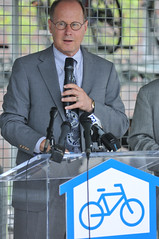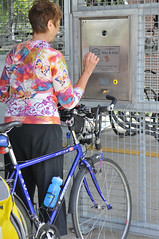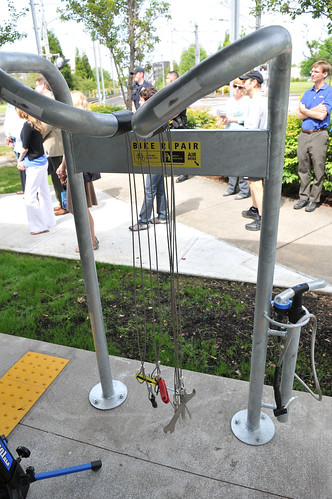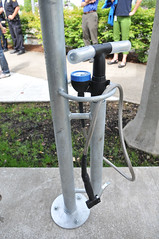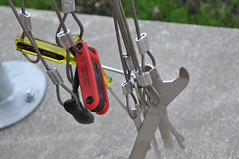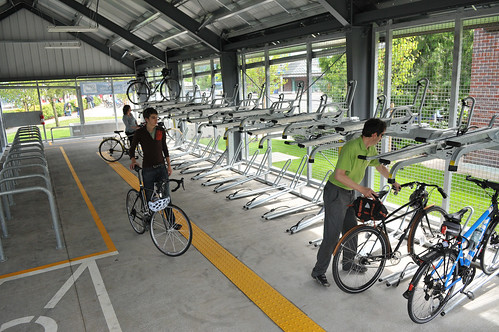
(Photos © J. Maus)
Nearly one year after completing their first new Bike & Ride facility at the Sunset Transit Center, TriMet cut the ribbon on two more this morning: one at the Beaverton Transit Center and other at Gresham Central.
A special ribbon-cutting event was held at the Beaverton location, which is the largest Bike & Ride facility in TriMet’s system.
The 100 bike capacity, fully secure, card accessible facility was hailed by a cast of assembled dignitaries which included Beaverton Mayor Denny Doyle, Washington County Commission Chair Andy Duyck, Bicycle Transportation Alliance Executive Director Rob Sadowsky, and TriMet General Manager Neil McFarlane.
Prior to the event, I asked McFarlane how this project fits into the ongoing issue of bike capacity (or lack thereof) on MAX trains. “There’s only so much space on the [rail] cars, no matter how many hooks we put on there,” he said, “If we’re really going to have a lot of cycling access to the MAX system we need to have a different way to solve the problem.”
Judging from the $1.4 million in federal stimulus funds TriMet just spent on three Bike & Rides (not to mention the similar facilities on the Portland State University campus), one way they plan to solve that problem is to encourage people to leave their bikes behind and take the train for the last leg of their trip.
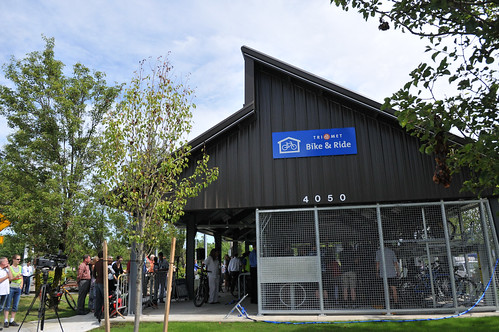
They picked the Beaverton Transit Center because it’s the number one access point for bike-riding MAX customers, with a total of 12% of all MAX riders at this location bringing their bikes, according to TriMet’s Carolyn Young.
“This is where the biggest demand is,” Young explained to me, “This is close enough to a lot of big employers out here that we’re really hopeful people will leave their bikes.”
For Young, a self-described “older woman cyclist,” the new Bike & Ride also beats out lugging her bike onto the train. “I don’t like lifting my street bike with packs up onto the hooks on the train. It’s heavy and I’d never try it during rush hour.”
A similar sentiment was expressed by Barbara Chapnick. Chapnick is the Chair of the City of Beaverton Bicycle Advisory Committee. During a speech this morning she described how she works in downtown Portland and the new Bike & Ride gives her more choices.
“Up until now,” she told the crowd of onlookers, media, and assorted bureaucrats, “I did not feel comfortable in leaving my bike at this transit center to MAX to Downtown.”
Chapnick was the honorary first customer of the new facility. She walked up to the gated entry with her bike in one hand and BikeLink access card in the other. She put her card in, pushed a button, and in she went.
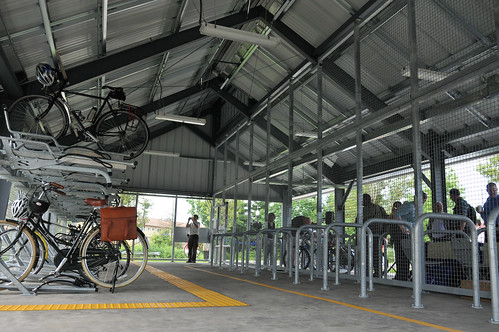
The facility itself if nicely designed. Inside the cage is light and airy, yet it feels completely secure (it’s also got video surveillance). Outside the cage, TriMet smartly added a row of standard bike staple racks, which require no special card to use and are sheltered from the rain (although being away from the main bus/train station area could make them a target for thieves).
A big bonus at the Beaverton Bike & Ride is the new bike repair station unveiled by TriMet this morning. Made by Dero Racks, the “Fixit” bike repair stand, a good selection of basic tools, and an air pump. (I’d love to see these repair stands pop up at bike corrals citywide.)
Another topic of conversation at the event this morning is how this large and attractive bike parking facility might spur new bike connections in the surrounding area. Besides the new bike lanes on Lombard leading into the Beaverton Transit Center, Washington County Commission Chair Andy Duyck mentioned that this gives added urgency to “Crescent Connection Project.” That project envisions a 12 mile, $12 million trail that would connect the Fanno Creek Trail in Tigard with the transit center.
Duyck, during his speech today, commented that the new Bike & Ride is indicative of a “sea change” in Washington County transportation culture. “It’s different way of looking at things than we’ve looked at them in the past… to realize that bike and pedestrian facilities are part of the overall transportation system.”
With more “small investments,” like this one, Duyck said, it means the County “doesn’t have to put in a much larger investment in more and wider roads.”
Funding and technicalities aside, for citizen activist Barbara Chapnick, it’s what this new facility symbolizes that makes it so important. “It certainly makes a profound statement about the City of Beaverton,” she said, “You are valued, your bike property is valued and your bike does belong!”
—See more photos in the gallery. Learn more about TriMet’s Bike & Ride facilities on their website.


